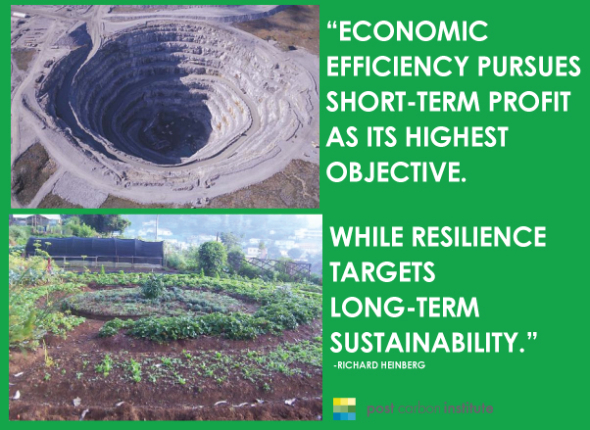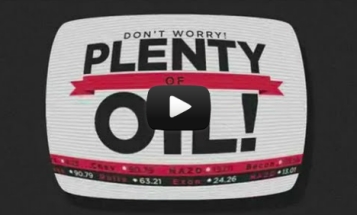MuseLetter #244 / September 2012 by Richard Heinberg
Download printable PDF version here (PDF, 104 KB)
With Arctic ice at record lows the impact of climate change is becoming increasingly clear. This month’s lead article looks at the case for building resilience in the face of the coming changes. Part 2 brings you the latest video from Post Carbon Institute Don’t Worry, Drive On, along with the script I wrote for it. The video is a response to the huge hype about unconventional oil. If you like it please share it with your friends and send it to your elected officials.
Building Resilience in a Changing Climate
Climate shocks are on the way. We’ve already spewed so much carbon into the atmosphere that a cascade of worsening crop failures, droughts, floods, and freak storms is virtually guaranteed. You, your family, and your community will feel the effects.
Ironically, however, avoiding climate change also has its costs. It makes sense from a climate-protection standpoint to dramatically and rapidly reduce our use of fossil fuels, which drive global warming. But these fuels largely, well, fueled the spectacular economic growth of the past 200 years, and weaning ourselves from them quickly now—while most industrial economies are over-indebted and starved for growth—could risk financial upheaval.
Oil, the most economically pivotal of the fossil fuels, is getting more expensive anyway. Cheap, onshore, conventional crude is depleting; its replacements—deepwater oil, tar sands, and tight oil—cost more to produce, in both dollar and environmental terms. Though high oil prices discourage driving (good for the climate), they also precipitate recessions (bad for the economy). While renewable energy sources are our hope for the future and we should be doing everything we can to develop them, it will be decades before they can supply all our energy needs.
In the face of impending environmental and economic shocks, our best strategy is to build resilience throughout society. Resilience is the subject of decades of research by ecologists and social scientists who define it as “the capacity of a system to tolerate disturbance without collapsing into a qualitatively different state that is controlled by a different set of processes.” In other words, resilience is the capacity to absorb shocks, reorganize, and continue functioning.
In many respects a resilient society defies the imperative of economic efficiency. Resilience needs dispersed inventories and redundancy, while economic efficiency—in its ruthless pursuit of competitive advantage—eliminates inventories and redundancies everywhere it can. Economic efficiency leads toward globalization, resilience toward localization. Economic efficiency pursues short-term profit as its highest objective, while resilience targets long-term sustainability. It would appear that industrial society circa 2012 has gone about as far in the direction of economic efficiency as it is possible to go, and that a correction is necessary and inevitable. Climate change simply underscores the need for that course correction.

Building resilience means helping society to work more like an ecosystem—and that has major implications for how we use energy. Ecosystems conserve energy by closing nutrient loops: plants capture and chemically store solar energy, which is then circulated as food throughout the food web. Nothing is wasted. We humans—having developed the ability to draw upon ancient, concentrated, cheap, and abundant (though ultimately finite) fossil fuels—have simultaneously adopted the habit of wasting energy on a colossal scale. Our food, transport, manufacturing, and dwelling systems burn through thirty billion barrels of oil and eight billion tons of coal per year; globally, humans use over four hundred quadrillion BTUs of energy in total. Even where energy is not technically going to waste, demand for it could be substantially reduced by redesigning our basic systems.
For example, we could reduce transport energy used in food systems by producing food more locally; at the same time, we could reduce other fossil fuel inputs to those systems (fertilizers, pesticides, herbicides, and packaging) by changing farming practices and consumer habits. We could retrofit our buildings so they require far less energy for heating and cooling. And we could reduce the need for motorized transportation by redesigning cities around mixed-use neighborhoods that are friendly to pedestrians and bicyclists.
By cutting our reliance on fossil fuels, by reducing energy requirements in general, and by eliminating our economic system’s need for perpetual growth (and hence for perpetually increasing energy consumption), we can make our way of life less vulnerable to energy shortages and price spikes while also reducing carbon emissions.
Ecosystems build resilience through biodiversity. Thus if the population of one organism that plays a crucial role in an ecosystem is greatly reduced, another organism that performs a similar function will be there to take its place. When we reduce diversity in human systems in the name of economic efficiency, we trade away resilience and increase vulnerability to systemic collapse. For example, industrial agriculture favors monocrops, which present a huge opportunity to any pest that manages to evolve immunity to the chemicals that farmers use to keep it at bay.
Communities can build economic diversity and resilience by encouraging and investing in small businesses and family farms, rather than offering incentives to giant retail or manufacturing companies to locate in town, only to see them move or outsource jobs a few years later.
Feedback loops (either balancing or self-reinforcing) control energy flows and populations in ecosystems, stabilizing or destabilizing the system. Climate change is itself subject to both kinds of feedbacks: forests and oceans absorb carbon and help keep the climate system in balance, while melting permafrost releases greenhouse-enhancing methane, thus reinforcing global warming. Part of the challenge of building community resilience is to identify reinforcing and balancing feedback loops, to learn how they affect human systems, and to make them work for us.
Once we start down the path of building resilience, the positive effects become synergetic. For example, by reprocessing recycled materials locally rather than sending them to far-off countries for reprocessing, and by composting local food waste and sewage, communities can conserve energy while creating jobs, building topsoil, and reducing dependence on increasingly unreliable distant sources of food and materials. Again: resilience helps us adapt to inevitable shocks and changes, while also aiding proactive efforts to reduce energy consumption and thus avert future global warming. Building resilience helps us address a range of problems with just a few basic strategies.
Resilience can’t remove all the challenges and hardships ahead. For example, people typically don’t adapt to intense, prolonged drought—they move elsewhere, as tens of thousands did during the Dust Bowl of the 1930s. No strategy will guarantee immunity to impacts from acidifying oceans, melting glaciers, and weird weather. But resilience buys us a better insurance plan. And in the bargain, it might also revive our communities, create economic opportunity, and make life more satisfying.
Don’t Worry, There’s Plenty of Oil
Transcript
Our civilization runs on oil.
It's the cheapest, most energy-dense and portable fuel we've ever found. Nature required tens of millions of years to make petroleum, and we've used up the best of it in less than two hundred.
A little over a decade ago, eminent petroleum geologists calculated that global oil production would soon hit a "peak" and begin to decline, no longer meeting ever-rising demand. But oil industry spokesmen countered with the message, "Don't worry, there's plenty of oil!" and assured us that everything would be just fine.
So what actually happened? World crude oil production flat-lined in 2005, and oil prices went crazy. Wars erupted in the oil-rich parts of the world, and the global economy went into a tailspin. The term "Peak Oil" entered the lexicon.
The oil industry is now staging another PR counter-offensive. They're telling us that applying "new" technologies like hydrofracking to low-porosity rocks makes lots of lower quality, unconventional oil available. They argue we just need to drill more to produce more. Problem solved!
But wait. What's actually new here? Most of this technology has been around since the 1980s. The unconventional resources have been known to geologists for decades. What's new is high oil prices.
It's high oil prices that make unconventional oil worth producing in the first place. It takes lots of money and energy, not to mention water, to frack low-porosity rocks. And the environmental risks are staggering.
How does the economy handle high oil prices? Well, it turns out the economy hates high oil prices and responds by going into recession. Which makes energy prices volatile, rendering the industry subject to booms and busts.
So, what's the bottom line here?
Yes, there's still oil in the ground. We just can't afford it. In broad terms, the peak oil analysts were right. But the fossil fuel industry is winning the PR battle.
What really matters, though, is not who wins the debate, but how we prepare for the inevitable. We've got to wean ourselves off our high-energy lifestyle.
We'd be foolish to wait for events to settle the debate once and for all. Let's say goodbye to oil. It's saying goodbye to us.
Richard is currently on a speaking tour of Australia. You may be interested to listen to an interview he did there in which he explains peak oil, but also talks about his life, and chooses music to accompany the interview.
![[Power book cover]](https://richardheinberg.com/wp-content/uploads/2021/03/cover_POWERcatalog-proof_300x450.jpg)

